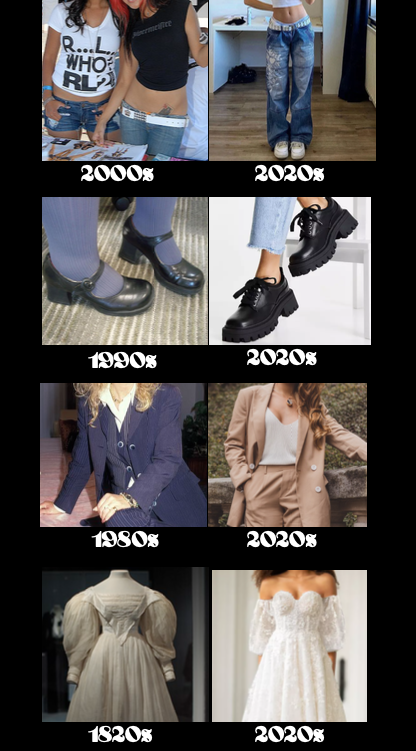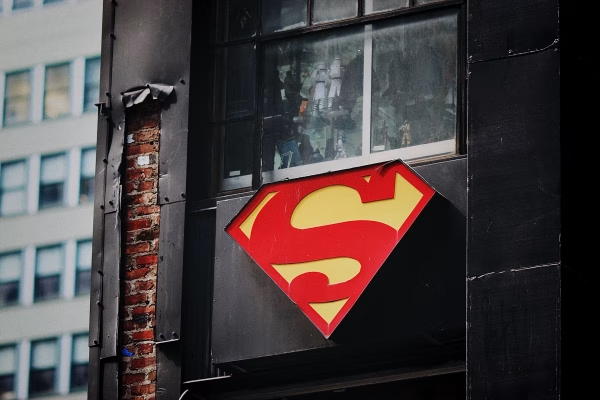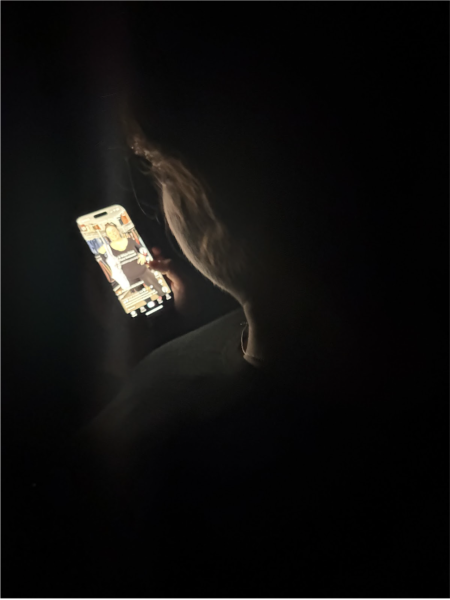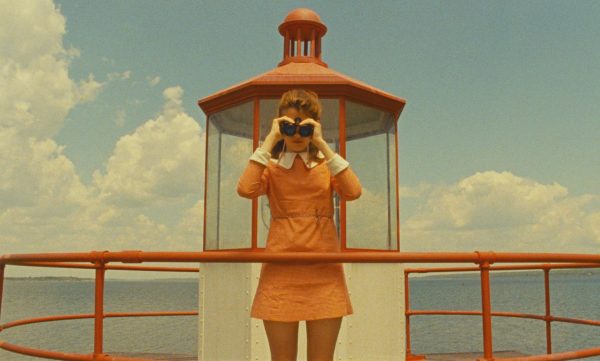20-year fashion cycle: Haute or Not?
Examining whether the 20-years fashion cycle exists and still holds true today.
Photos credit: Wikimedia Commons, YesStyle, ASOS, pxhere.com, theknot.com
Low-rise jeans, chunky shoes, blazers and little cardigans. All of these clothing articles may sound extremely different, but they all have something in common: They are, and were, in style. Clothing trends are not universal, but there is a general consensus in many of the more fashion-forward countries of what is most popular at the current moment. This is usually what one would see a celebrity wearing; people who the masses tend to imitate the most. Despite how cutting-edge some trends may seem, most have been recycled from the past to somehow make them more “modern,” such as the popular chunky shoes of the 1990s being made a bit more thick-bodied and in sneaker form to meet today’s style. What is more, throughout history a pattern in the cycle of trends has been noticed by many—it seems that approximately every 20 years, trends come back in style.
One trailblazer of a similar theory was London museum curator and critic James Laver, who conceived Laver’s Law in the 1930s. He sought to compress the complex cycle of fashion into an easily-digestible 150-year span, asserting that after about 50 years a trend is acceptable again, and after 150 years it is “beautiful” in society’s eyes. Not only does his cycle apply to fashion, but to nearly any creative medium, including architecture and music. Though Laver’s timespan is far longer than the current industry-used concept of the “20-years rule,” it claims something similar: what was once in style inevitably comes back.
To understand the 20-years rule, we must first understand how trends initially come to be. Designers and innovators are constantly on the hunt for what could be the “next big thing,” found in numerous places. Sometimes trends are found on the runway, other times in films or even just on the street. Now, with the prevalence of social media, we are increasingly seeing trends come from internet influencers. Whatever the case, once a trend is established it becomes highly sought after, only really attainable by those of high wealth or social status and found in the most couture of stores. This is when the emulation phase comes into play, when the general public notices and attempts to follow suit. Finally, big brands create cheaper, more accessible versions of what is trending for the consumption of the market.
“Some trends turn out to be short-lived, whereas others continue to evolve as they are more about lifestyle choices and style, rather than conspicuous consumption, [buying things for the sole purpose of displaying one’s wealth],” Anne Lise Kjaer, founder of trend management consultancy Kjaer Global, said.
It is true that the 20-years cycle is not always 20 years, and in fact has become increasingly shorter with the heightened accessibility of high fashion. Almost all of the most “Haute Couture” (or high-end) brands have websites with latest releases, so even if an admirer cannot afford something they can replicate it in their own way. Many fashion bloggers—often on Instagram or TikTok—have also shown the masses how to look chic with what they already have and often set the stage for what is popular. One such influencer (with more than 26 million Instagram followers) is Italian fashion blogger Chiara Ferragni, who inspired many designers worldwide to imitate “military style,” a chic way of dressing up camouflage. She uses social media to guide people in their fashion consumption.
“I think that social media will be part of everyone’s life and considered normal, not something only for youngsters,” Ferragni said in an interview with APM News.
Though the accessibility of social media has influenced the length of the fashion cycle, there is additionally an inevitable gender divide in the time-span. Mrs. Lynn Nelson, an Arlington-based bridal fashion designer and wedding planner with a focus on taking vintage wedding gowns and restyling them for current trends, has noticed this difference.
“I’ve also studied men’s wear, so I do see that it moves more slowly,” Nelson said. “If you look at men’s wear now, the pants are tighter and they’re shorter in length and you’re now seeing that in tuxedos. Just in the last year I’ve seen them more trendy in tuxedos. I’ve never ever actually seen that in my time in the fashion industry, but when I look back in the ‘40s, the men’s pants styles were a little more in-trend like they are now.”
Despite these impacting elements, the 20-year fashion cycle continues to hold true to an extent. This is evident today. Many young people can attest that the early 2000s is making a comeback in a huge way. The aforementioned low-rise jeans can be seen on practically any female model’s Instagram account, and we all know that was Paris Hilton’s staple piece, popular in the 2000s. However, even within these 2000s fashion pieces, trends from older decades can be seen.
“Choker necklaces, hair parted down the middle with barrettes—we look at those trends now and think they’re from the ’90s, but in reality, those trends actually first surfaced in the ’60s or even before then in the ’20s,” Xina Giates, New York-based stylist, told Insider magazine. “Trends keep reproducing themselves but they slowly evolve each time a decade comes back in vogue.”
In terms of what can be expected for the future, no one can say for sure, although the 20-years cycle makes it much easier to predict. With the way things are going, and in accordance with the rule, the early 2000s are likely to stick around for a bit.
“I think it has to do with nostalgia,” Nelson said. “I think that looking back at what you wore or what your grandmother wore brings that warm feeling of the past and fond memories.”














Janet • Apr 20, 2022 at 8:55 PM
I loved it when you read it to me, but the pictures punctuate it.
Luis Miguel • Mar 17, 2022 at 3:10 PM
It is instigating to think abt this
it does feel like the most loved pieces of an age tend to stay for a while until they fall in disuse and forgetting
while the less trendy pieces of a time will be renovated by a sooner generation with a different view of it
since these pieces did not fully reached their way to the mainstream consumer at their time of peak and have more of a novelty feel to it